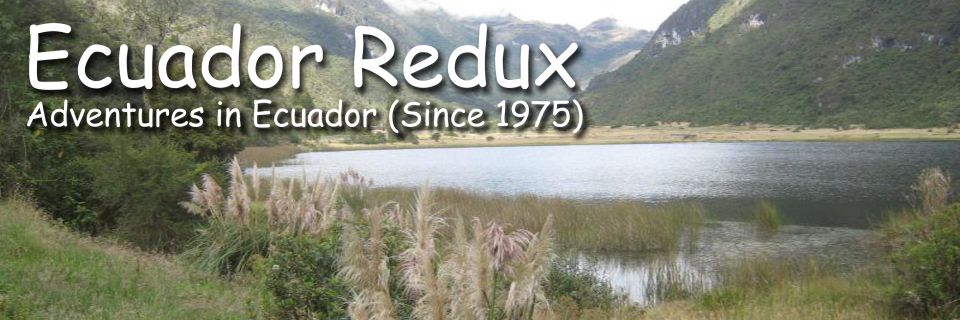Habitat III: Part Two
Habitat III in Quito – Part Two
Our Travel and Stay
Flight to Quito on Tame Air

A Tame Airbus
The beauty of being Cuenca expats was that we could attend Habitat III with only a 45 minute domestic flight. But with Tame, the national airline, anything could happen. Shortly after everyone boarded the plane, it was announced that someone had forgotten to charge a battery (recargar bateria) on the plane!! Seriously?? Tame is the butt of jokes among locals and expats because it’s unreliable — so we chuckled. However other passengers got out their phones and started to leave the plane until they were directed back to their seats. Sometime later, we were told to leave the plane. We sat in the gate lounge for 5 minutes and were then shuffled back onto the same plane. Really?? I inquired and was told there’s a 30 minute rule: can’t leave people on plane more than 30 minutes. Good rule. I needed a bathroom break. Our flight to Quito for Habitat III was uneventful. With no connecting flight, we had no problem.
Airport Taxi to Quito & Airbnb Stay

Quiport, Quito’s Airport
Arriving at the modern Quito airport (“Quiport”) located in gorgeous Valle de Tababuela, we quickly found our 2 bags and a taxi cab to our rented room: $25 for a 40 minute ride from Tababuela to Quito. A new, lightly traveled highway gave way to zig zagging steep narrow, cobblestone streets halfway into the trip. I called our Airbnb host in time for him to greet us at the street. We would be staying with him and his cousin on the 4th floor of an older mid-rise building on a main artery, 6 de diciembre, near Habitat III. The building had 2 elevators – one for even numbered floors and one for the odd – and the former was being repaired, so we “elevated” to the 5th floor and walked down to the 4th floor. The apartment had small spaces but lovely views of Mt. Pichincha and lots of glass. We had the Master Bedroom with attached bath. Great!
Our Quito hosts are dedicated to their airbnb business and their family ties made it possible. We were staying in the host’s mother’s 3 bed apartment, as she’s in the US caring for a ill sister. They also rented out 2 other apartments – in more modern, luxurious buildings I was told. Both hosts are single men who live simply. The kitchen had just the very basics and only 4 sets of dishes. But it was enough. The water heater in the apartment was tiny and gave me just 5 minutes of hot shower. But it was enough. The refrigerator we shared was smaller. But it was enough. One host ate lots of rice and eggs and coffee; and the other lots of canned tuna and avocado. A big pot of rice was eaten by all, usually for breakfast. We had a lovely stay.
When we discovered a delicious, reasonably priced Colombian restaurant nearby, Hacienda de Los Arrieros, we frequented it most nights. One of our hosts commented that it was expensive yet our bill was typically $14.50, including beer and big tomate de arbol juice; plus 2 complementary shots of licorice liquor with fresh lime. The liquor was John’s burden as I’m literally allergic to alcohol. John bore his burden well!
Attending Habitat III: Joys and Sorrows
Arriving 2 days before the Monday start of the full conference, we had time to register. However, when we tried to get in the appropriate line we were immediately rejected because we didn’t have a registration code on our cell phones. ALOT had happened since John and I had registered months ago and we didn’t have the code. Ugh. I began asking other Habitat staffers in the park about our problem and they escorted us into a special left lane. Great! We were eventually photographed and given badges. Our Airbnb hosts did not fare as well, however.. They registered the next day after waiting 3 hours in the hot sun and getting a sun burn.
Once in the main venue, the Casa de Cultura, our adventure had just begun. There was no daily sheet of times, places, and events and the building is large, circular, and has 3 floors. I learned later that there was a phone app for Habitat that may have worked! Being old folks, we were relying on a laptop which showed the website was down. The information booths were staffed with untrained people. So, so, so. We went to each room of the venue, where we found 8 by 11 sheets of paper next to each door, usually with a guard standing in front of it. This took a while but we found presentations of interest.

A Sunday Afternoon at The Island of Grande Jatte, Georges Seurat, 1884
Sunday morning was much more crowded and access to Casa de Cultura required waiting in a very long, slow line of people ahead of only five security scanning machines. (TV news later said 4 hour waits.) I realized we did not want to waste a day in THAT line, but we continued toward the entrance when someone said we should try another line, to the left, that was much shorter. As we walked by the guard, I heard him say “tercer edad.” Great, I thought. With John’s white hair, we’re given priority as senior citizens. (Later, John played his part to the hilt, pulling out a folding cane to complete the image.) The left lane contained many presenters and other important people, but an hour later we shuffled past security. It was crazy!
Throughout all of this mess, the people trapped in lines – from all over the world — were patient and polite. Many carried umbrellas for the sun, in the park, giving the whole scene a surprisingly pastoral feel. I had mental images of Georges Seurat’s famous painting, A Sunday Afternoon on the Island of La Grande Jatte.
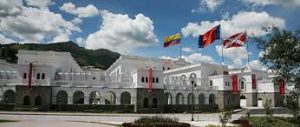
Centro de Arte Contemporaneo
As a member of World Resources Institute (WRI), John knew about WRI’s special session Sunday, which included dinner, at the Centro de Arte Contemporaneo. ((The building was formerly the Military Hospital, has been restored and has a lovely location perched on a hill.) John is always interested in free food so we left the Casa de Cultura, caught a cab, and stayed at WRI for the afternoon sessions. Late in the afternoon I was feeling out of place — I wasn’t wearing “conference professional” attire — and needing some food, so I left for “home” while John stayed for a late meal and networking.
Festival of Light in downtown Quito: Sharing Public Spaces with a Quarter Million Ecuadorians
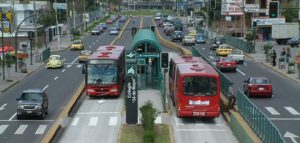
Ecovia — bus rapid transit
When I got home around 6 pm, our host arrived shortly after, and suggested the two of us catch the Ecovia (bus rapid transit) to downtown to see the Festival of Light. I was in luck! I had a native guide. So I finished my meal, messaged John, and off we went.
Our host and I paid our 25 cent fares and waited 2 or 3 minutes for the Ecovia to arrive at our 6 de diciembre stop. Fifteen minutes later we got off at the Marin station downtown and headed up Chile St to the Plaza de Independencia and along Garcia Moreno Street past a resplendently lit colonial government building and the renowned Jesuit Church,
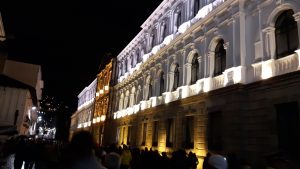
Fiesta de La Luz, Quito, government building
La Compania. The street was packed with people watching the spectacle in front of them. The drab gray stone exterior ot La Compania was brightly lit up with reds, blues, and yellows. I know this church and I was not prepared for what I saw. I couldn’t tell, at first, if the color was created by the lights or painted on. How could a drab 18th century church be dressed up like dancers in a Las Vegas show? I later confirmed that the church had been painted – right over the stone. What would the 18th century Jesuits have said?
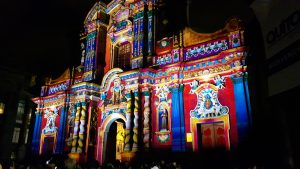
La Compania during Fiesta de La Luz
After taking pictures of this spectacle, we headed up to meet with the other host, who was guiding other airbnb visitors here for Habitat III – 2 Colombian architects. Public museums were ALL open for the occasion and we toured the exhibits of Museo de la Ciudad together. I would have stayed longer but I had the only apartment key and John messaged that he was in a taxi headed toward “home.” Yikes! He’d have to wait as it took a while to find a taxi that night. But he’s a patient man.
Tuesday night John and I went with our host to see more of the Festival of Light events. By this time, we knew that a highlight of the event was a 9 minute light show projected onto the face of Santo Domingo Church and Convent — an early 17th century building. None of us had seen it. With the large plaza in front of the church, the location was ideal for a light show that could be seen by many. The only problem was that the light show was so engaging and so popular that EVERYONE wanted to see it. Hundreds of thousands of people were attending these events. The crowds
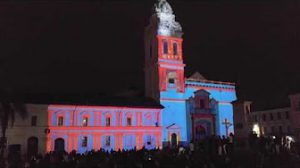
Light Show, Santo Domingo Church
were insane but our host pushed through them and we arrived at the plaza intact and enjoyed the show. When it was time to leave for other events, our host again pushed through the crowds but we were getting crushed by the crowd. As soon as we could extract ourselves we did. We’d lost our host.
I had a bad experience in a jammed crowd at a Jimmy Buffett concert in Chicago years ago! Thoughts of the people getting trampled to death at Mecca were floating in my mind. I did not want to be a casualty. I texted our host but he didn’t get it. He called me but I never heard the call amid the noise. John and I found a safe spot and just reflected about what had happened. I was shaken up. John, intelligently, suggested to a few of the many police near us that they were needed at the overly crowded bottleneck. They seemed not to be aware of the problem.
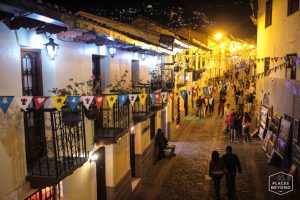
La Phonda Street
There was a reason for the bottle neck, it was the only good route to the church. We walked far out of our way to circle back to other events. But, serendipitously, we ended up on the famous La Rhonda street, which was indeed narrow, winding, and packed with balconies. It was also filled with dim lights and lots of people having a good time. A great many little hole-in-the-wall cafes were displaying GIANT empanadas and other traditional food at the entry doors. This night, La Rhoda was oozing with atmosphere. We might have stopped to eat but wanted to see other events before midnight.
We managed to see several more events, but none as powerful as La Compania or Santo Domingo. We did not realize we had missed another highlight of the Fiesta de La Luz — a light show at La Merced Church with images of stars, planets, and the cosmos. Tired from the conference and long evening, we headed back to the Marin bus hub, caught the

A map of Quito survey results by Cuenca University students
next Ecovia and returned home safely before midnight.
The following day, John and I visited two “Habitat III Village” events – which felt like a “field trip” because they were dispersed across the city. The first was a project of Cuenca college students, who we wanted to meet. When we arrived a little late they seemed not to be ready, so we waited but asked questions. Questions lead to conversations and soon all of the students were engaged in showing us their work, which they displayed on a large floor map of Quito, with different colored balloons showing differing percentages of awareness by Quitenos of Habitat III. In general, the neighborhoods closer to city center were more aware of the upcoming Habitat III.

Stone stairway through Alameda neighborhood to Itchimbia Park.
The next “Village” event was a hike, up 250+ stone steps in the Alameda neighborhood to the Parque Itchimbia on a large hill overlooking downtown. In the middle of the grass-covered park sat a large new building of glass with some fancy metal work connecting it all. It was ornate and sleek at the same time. It’s called the Palacio de Cristal and used for large events.
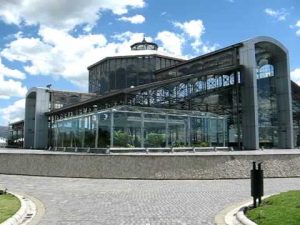
Palacio de Cristal, Parque Itchimbia
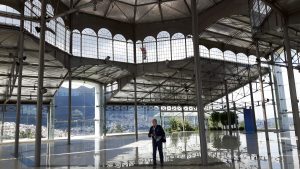
Inside the Palacio
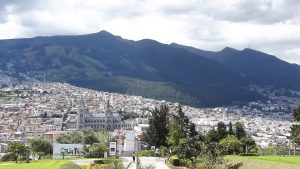
View from Itchimbia Park
At the east end of the large grassy park, next to the “911” municipal
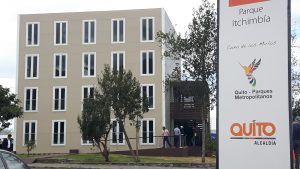
Model of Barcelona Housing Systems at Itchimbia Park
building, we saw a cube-shaped 4-story building with regularly spaced windows, trimmed in white. That had to be it: the “Affordable Housing Solutions” demonstration by Barcelona Housing Solutions (BHS). When we arrived, it was open and well attended. We jumped into the ongoing tour, in which 2 builders were peppering the guide with questions. I asked about the purchase price of the 58 square meter unit and was told $45,000 because the price could not be more than $880 per square meter including the land. Our hosts thought the price tag was high for low income people, but they were interested enough to visit it the final day of Habitat. ($80k is about the upper limit for housing of middle income households in Ecuador.)
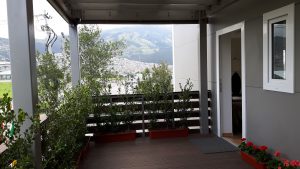
The attached deck
John quietly absorbed the tour and made astute observations, which I shared in Part 1. Principally, the BHS system presents a one-size fits all solution, which doesn’t make sense for housing. Nevertheless, there were interesting features, such as the windows as doors. The housing units also included solar panels displayed on metal roofing in the adjacent field. A closet for a washer & dryer was included in each unit. An attractive deck space was attached to the cube to provide stairs to the upper floors and for added space. The deck was decorated with attractive plants. I can’t help but imagine clothes drying on the decks and a laundry closet being little used in a poor
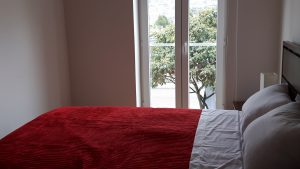
Typical bedroom
neighborhood where an expensive dryer is a non-starter when you have a solar dryer – the sun – available. We hope this housing will be enjoyed by middle class Ecuadorians.
That’s our review of Habitat III.
Stay tuned: Guaguas de Pan and Colada Morada on the Day of the Dead
Category: Quito, Travels in Ecuador, Uncategorized
